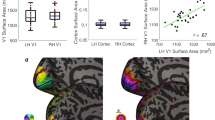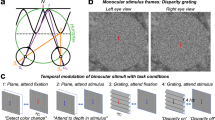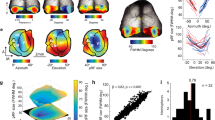Abstract
SOME patients with lesions in visual cortex lack conscious visual experience but, when tested, exhibit a significant ability, termed 'blindsight', to discriminate visual stimuli1–3,27. Here we report two different visual displays that induce blindsight in normal observers. Using an objective measure, we show that conscious experience remains defective at presentation times much longer (1 s) than the onset of visual sensitivity (˜60 ms). To obtain this effect, we generate a contrast between visual textures and then conceal the contrast by superimposing 'complementary' textures. Complementarity can involve either opposite motion or binocular rivalry and orthogonal orientation. In both cases, observers locate the texture contrast reliably but do not, by either subjective or objective measures, consciously experience it. Taken together with present knowledge of the visual cortical site(s) at which opposite motion and rivalrous orientation interact4–7, this observation bears upon the functional anatomy of conscious visual experience.
This is a preview of subscription content, access via your institution
Access options
Subscribe to this journal
Receive 51 print issues and online access
$199.00 per year
only $3.90 per issue
Buy this article
- Purchase on Springer Link
- Instant access to full article PDF
Prices may be subject to local taxes which are calculated during checkout
Similar content being viewed by others
References
Pöppel, E., Held, R. & Frost, D. Nature 243, 295–296 (1973).
Weiskrantz, L., Warrington, E. K., Sanders, M. D. & Marshall, J. Brain 97, 709–728 (1974).
Storeig, P. & Cowey, A. in Progress in Brain Research Vol. 95 (eds Hicks, T. P., Molotchnikoff, S. & Ono, T.) 445–459 (Elsevier Science, Amsterdam, 1993).
Qian, N. & Andersen, R. A. J. Neurosci. 14, 7367–7380 (1994).
Logothetis, N. K. & Schall, J. D. Science 245, 761–763 (1989).
Leopold, D. A. & Logothetis, N. K. Invest Ophth. Vis. Sci. suppl. 36, 813 (1995).
Dobbins, A., Jeo, R. & Allman, J. Soc. Neurosci. Abstr. 20, 624 (1994).
Qian, N., Andersen, R. A. & Adelson, E. H. J. Neurosci. 14, 7357–7366 (1994).
Green, D. M. & Swets, J. A. Signal Detectability and Psychophysics (Wiley, New York, 1967).
Fox, R. in Binocular Vision (ed. Regan, D.) 93–110 (CRC, Boca Raton, FL, 1991).
Sidis, B. The Psychology of Suggestion (Appleton, New York, 1898).
Adams, J. K. Psychol. Bull. 54, 383–405 (1957).
Marcel, A. J. Cogn. Psychol. 15, 197–237 (1983).
Meeres, S. L. & Graves, R. E. Neuropsychologia 28, 1231–1237 (1990).
Graves, R. E. & Jones, B. S. Cogn. Neuropsychol. 9, 487–508 (1992).
Merikle, P. M. Am. Psychol. 47, 792–795 (1992).
Greenwald, A. G. Am. Psychol. 47, 766–779 (1992).
Schacter, D. L. Proc. natn. Acad. Sci. U.S.A. 89, 11113–11117 (1992).
Farah, M. J., Monheit, M. A. & Wallace, M. A. Neuropsychologia 29, 949–958 (1991).
Malik, J. & Perona, P. J. opt. Soc. Am. A 7, 923–932 (1990).
Rubenstein, B. S. & Sagi, D. J. opt. Soc. Am. A 7, 1632–1642 (1990).
Knierim, J. J. & Van Essen, D. C. J. Neurophysiol. 67, 961–980 (1992).
Press, W. A., Knierim, J. J. & Van Essen, D. C. Soc. Neurosci. Abstr. 20, 838 (1994).
Karni, A. et al. Soc. Neurosci. Abstr. 19, 1503 (1993).
Malach, R., Amir, Y., Harel, M. & Grinvald, A. Proc. natn. Acad. Sci. U.S.A. 90, 10469–10473 (1993).
Crick, F. C. & Koch, C. Nature 375, 121–123 (1995).
Weiskrantz, L., Barbur, J. L. & Sahraie, A. Proc. natn. Acad. Sci. U.S.A. 92, 6122–6126 (1995).
Author information
Authors and Affiliations
Rights and permissions
About this article
Cite this article
Kolb, F., Braun, J. Blindsight in normal observers. Nature 377, 336–338 (1995). https://doi.org/10.1038/377336a0
Received:
Accepted:
Issue Date:
DOI: https://doi.org/10.1038/377336a0
This article is cited by
-
Distinguishing unpredictability from uncertainty in entrepreneurial action theory
Small Business Economics (2023)
-
Conscious awareness modulates processing speed in the redundant signal effect
Experimental Brain Research (2021)
-
Unconscious processing of invisible visual stimuli
Scientific Reports (2016)
-
Throwing in the dark: improved prediction of action outcomes following motor training without vision of the action
Psychological Research (2014)
-
Responses of pulvinar neurons reflect a subject's confidence in visual categorization
Nature Neuroscience (2013)
Comments
By submitting a comment you agree to abide by our Terms and Community Guidelines. If you find something abusive or that does not comply with our terms or guidelines please flag it as inappropriate.



